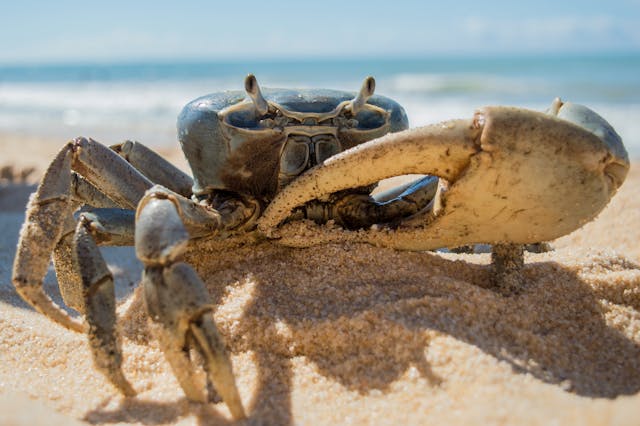Have you ever seen a hermit crab without shell? Have you any idea about the function of the shell of a hermit crab? The time has come to share with you various unknown things about hermit crabs without a shell. Fasten your seat belt and try to sail to learn the different aspects of hermit crab without the shell.
The Hermit Crab Without Shell: A Brief Description
Generally, Hermit crabs protect their soft, helpless abdomens from predators by reusing empty snail shells. They trade for shells with other crabs for a better fit or a less damaged shell. This specimen defines the crab without its typical borrowed shelter.
More than 800 species of hermit crab are there. Most of them possess a nonsymmetrical abdomen covered by a secured-fitting shell.
Functions of Shell for Hermit Crabs:
What will happen if a hermit crab without shell is trying to survive? The function of their shell is defined as well as its significance.
- The hermit crabs hide in their shell to protect their exoskeletons giving a sense of security.
- It prevents their bodies from drying out.
- The shell protects the environmental elements.
- The shell protects against heat, cold, and light effects.
- It protects their lives from any adverse conditions.
The Molting Process:
Shell removal happens when a growing crab is required to deal with both its housing and its exoskeleton to adjust its larger body size. This normal process is called molting. All crabs do not abandon their shell by molting.
On the other hand, an inhospitable environment called stress is a poor-fitting shell. It may be too large, too heavy, or too small.
Duration of a Hermit Crab’s Molting Process:
Hermit crabs are required to molt once every 12 to 18 months. It depends on the size and species of a hermit crab. The smaller-sized crabs will molt more frequently than larger ones.
How Long Can A Hermit Crab Live Without A Shell?
The lifespan of a hermit crab is about 15–20 years. They need a shell or suitable object to protect themselves from attackers. It is treated as their home.
These nighttime animals carry their homes on their backs. They utilize an old animal shell instead of creating their own.
The shell regulates their body temperature and moisture levels. Without a shell, they may struggle to survive or more specifically we can say that the hermit crab without shell cannot survive for long.
As a resourceful creature, they will try to find other objects to use as protection. They may die if they cannot find a shell or suitable object.
The hermit crab can withdraw into its body when threatened. If they outgrow its shell, it will look larger. It promptly climbs out of the smaller one and into the new one.
It should be kept in mind that they find happiness in a good environment. Any atmospheric changes may be a significant reason to change their shell constantly.
Common Signs That Show the Hermit Crab is Ready To Molt:
Are you curious to know when the hermit crab is ready to molt? The hermit crab just changed its shell and there is a possibility of molting. This will not happen always. There are a few signs that show they are preparing for a molt.
- Hermit crabs spend a lot of time by the water bowls and like to stock up on water in their shell. The hermit crabs of pre-molting also like to take frequent dips in salt water. Hence, make sure to have plenty salt water of in your tank at all times. You can be sure the crab has been utilizing it if the spot in the water is caused by substrate or waste.
- The hermit crabs are spending a lot of time digging and digging much more before a molt. Hence they find a decent spot to spend the several month-long tests.
- They seem less active than usual. They tend to slow down before a molt. They move around their environment much less. In this situation, the crab will spend most of its time eating, drinking, and resting.
The Process To Get Back The Hermit Crab Into Their Shell:
The body of the hermit crab is very fragile. We have to be more careful to put it back into their shell. The following steps will be helpful to do the same.
Process 1:
- Pick up the hermit crab behind the leg carefully.
- Scoop them up by using a spoon.
- It should be ensured that there are no external injuries on their bodies.
- If everything is found fine, then it is time to check the shell.
Process 2:
- Eliminate the debris, bacteria, or irritants in the carapace after boiling the shells in dechlorinated water to cover the bottom.
- The dechlorinated water helps to provide moisture to the body.
- The moisture makes it easier to get it back into the shell.
Process 3:
- A big container is required to place and take the shell and hermit crab
- Any force should not be applied to the shell.
Reasons to Change the Shell of Hermit Crabs:
Generally, hermit crabs try to stay in their shell. The shell is their home. But there are several reasons why they leave or change their shells including:
For protection:
The shells of Hermit crabs are treated as their home. Hence the hermit crab without shell means there is no home to survive. This nighttime animals carry their homes on their backs. They utilize an old animal shell instead of creating their own. They can withdraw into its body when threatened. If they outgrow their shell, it will look larger. It promptly climbs out of the smaller one and into the new one.
Universal Substitution:
The Hermit Crab may be able to occasionally notice what would be a better suit for them than the current one. They leave their current shell after this happens and then enter into the new one. This procedure happens instantly.
Change in size:
The lifespan of a hermit crab is about 15–20 years. They enlarge after passing time but their shell does not. Thus, they must be free of it and replaced with a larger one.
Attack from within their shell:
Another reason may be something alien has gotten stuck inside the shell. It may be a parasite, a bacterial or fungal infection, or even small stone pieces. The crabs may become so disturbed that they must leave and look for another place to live. Necessary precautions are to be followed as this occurs most frequently. Clean water and healthy food can help avoid infections by keeping them at bay.
Searching for a better environment:
It is more important to maintain the temperature and humidity in a specific range for the hermit crab to remain healthy. It should be kept in mind that they find happiness in a good environment. Any changes in the atmosphere are also a significant reason to change their shell constantly.
They might be ill:
The hermit crab illness or other conditions frequently happen to diseases that will kill them. Shell rot leaves holes in the victims’ bodies and causes death. They may even come out of their shells under these circumstances. This may happen since it is unsettling for them to remain there. Moreover, the germs can grow abundantly due to the temperature inside the body is warmer than the exterior.
Pollution from microplastic:
Plastic debris could be noticed on the beaches. The crab’s choice of shell is impacted by microplastic contamination. A crab might occasionally confuse a plastic object for a replacement, but they soon change it. As a consequence, the selection of the appropriate house for protection becomes difficult.
Final Thought:
In conclusion, we must say that the shell is a protective cover for hermit crabs. But we should not be panicked too much after seeing the hermit crab without shell. It may happen due to several reasons. But it should be ensured before taking any action to encourage the hermit crab to use its shell again.
Moreover, we must provide many shells if multiple hermit crabs are in the tanks. It should be noted that the body of the hermit crab is very fragile. We must be more careful to put them back into their shell. Hopefully, this article will enrich your knowledge about hermit crabs without shells.
When hermit crabs are unable to locate a shell, do they perish?
Hermit crab without shell are vulnerable to attack. But they are resourceful creatures and will try to find other objects to use as protection. They may die if they cannot find a shell or suitable object.
What do hermit crabs do after they outgrow their shells?
Hermit crabs will leave their current shell and start searching for a new one. This can take days or even weeks, and the hermit crab is vulnerable to attack during this time.
Do hermit crabs need a shell to survive?
Hermit crabs need a shell or suitable object to protect themselves from attackers. It regulates their body temperature and moisture levels. Hermit crab without shell may struggle to survive.
How many species are there of hermit crabs?
More than 800 species of hermit crab are there.
What are the Functions of Shell for Hermit Crabs?
Several functions of the shell for hermit crabs such as hiding in their shell to protect from attackers, and prevent their bodies from drying out. It also protects the environmental elements like heat, cold, and light effects, and any adverse conditions.







